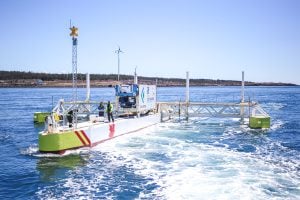
Environment
The truth about carbon capture
Carbon capture is big business, but its challenges fly in the face of the need to lower emissions. Can we square the circle on this technological Wild West?
- 5042 words
- 21 minutes
This article is over 5 years old and may contain outdated information.
Science & Tech

I climb an industrial metal staircase and step through a narrow doorway, emerging onto the flat cement roof of St. Lawrence College’s Sustainable Energy Applied Research Centre in Kingston, Ont. A 285-square-metre mishmash of 64 solar panels, arranged in rows, five storeys above the ground, occupies most of the space. I didn’t know that a world-class test facility could be this small.
Beside me, Rob Andrews, a brighteyed researcher sporting a tweed cap, wants to impress. “Want to see a jumble of cables?” he asks. We have to step over pipes to reach the control panels, where 224 red wires are routed into data loggers that are connected to Andrews’ computer.
Andrews, a Ph.D. student in mechanical engineering at Queen’s University, also in Kingston, is working on a project to help scientists better understand the factors affecting solar panel performance in cold, snowy climates. Data gathered from this $250,000 Open Solar Outdoors Test Field (OSOTF), collected at five-minute intervals since January 2011, include temperature, light spectrum and voltage and current measurements, as well as photos of the panels’ surfaces, which are used to determine snow cover. When considered alongside details such as the size and composition of each solar panel, the type of glass coating and the angle at which the panel is positioned, these results could help designers and manufacturers optimize photovoltaic systems for use in specific locations.
One early finding from the study is that snowfall results in a net gain in energy. Light reflecting off the snow — the albedo effect — compensates for any snow that is covering the panels. Although the reflected light contributes a small percentage of the total energy collected, Andrews and his supervisor, Queen’s mechanical engineering professor Joshua Pearce, were inspired to design an apparatus to boost the energy gathered from reflected light. Their solarpanel- shaped structure is positioned directly in front of a solar panel, forming a V, and reflects light that would otherwise be absorbed by the ground back onto the solar panel. Preliminary tests suggest that this arrangement can increase power yields by 23 percent to 30 percent.
Pearce is also using OSOTF data to determine how the “intensity map of the colours of light coming from the sky from a bunch of different angles” relates to panel performance. He is working with solar cells composed of multiple layers, each with differing spectralabsorption properties. He envisions a time when solar cell construction is tailored to a region’s sunlight profile.
After about two more years of testing, the complete OSOTF dataset will form the basis of a generalized model to predict how solar panels perform in local conditions anywhere in Canada. “We’re bringing it to the mainstream,” says Adegboyega Babasola, lead researcher at the Sustainable Energy Applied Research Centre. The plan is to eventually develop an online tool that will allow homeowners to determine whether it makes sense to go off-grid, given their local weather, panel types available and current costs.
The project is a prime example of what can be achieved through collaboration: Queen’s University supplied the theoretical foundation, and St. Lawrence College students built the system. The results are being integrated into the college’s curriculum. Several corporations donated the solar panels and other equipment; costs would have been prohibitive otherwise. In return, they get expensive, difficult-to-obtain data.
The “open” in Open Solar Outdoors Test Field stands for open source, with all the connotations of collaboration and sharing open-source software. “No matter how smart you are,” says Pearce, “10 people in your field are even smarter.” He has made the designs of the test field available online (appropedia.org), and the raw data gathered thus far will follow shortly. The hope is, says Pearce, that this openness will be a “force multiplier” to advance solar technology and the industry.
Meanwhile, the question that Pearce is asked most often when giving talks in Canada has already been answered. Do solar panels work in places that get cold weather and snow? Absolutely.
Are you passionate about Canadian geography?
You can support Canadian Geographic in 3 ways:

Environment
Carbon capture is big business, but its challenges fly in the face of the need to lower emissions. Can we square the circle on this technological Wild West?

Environment
From energy-efficient stadiums to solar-powered boats, making leisure time clean and green is all the rage

Science & Tech
Where and how we live affect how much energy we consume. Here’s what Canada would look like if the provinces and territories were scaled to represent the amount of energy they use.

Science & Tech
In the Bay of Fundy, technicians are putting a groundbreaking new tidal technology through its paces